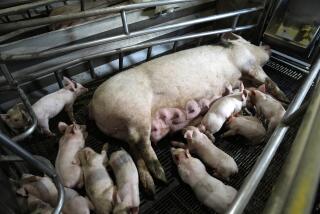New meat label to track livestock from birth to slaughter
The meat industry is a global business, but many consumers don’t realize how far their hamburger may have traveled to end up on their plates.
New federal labeling rules set to take effect Saturday will illuminate that process by requiring meatpackers to list where livestock was born, raised and slaughtered.
Current law requires companies to list all countries involved in these steps, but it doesn’t require them to be specific about which activities took place where.
The new rules update a law known as country-of-origin labeling. The changes to COOL are being applauded by consumer advocates and some U.S. beef ranchers who see the regulations as a way to strengthen food safety and boost transparency about where meat is coming from — crucial during any outbreak of food-borne illness.
Major meatpackers such as Cargill Inc. and Tyson Foods Inc. oppose the law as wasteful and costly. They contend that the U.S. already has rules in place to enforce food safety and fear the law will hurt demand for imported meat.
The USDA estimates that compliance will cost the meat industry $53.1 million to $192.1 million.
Included in those costs will be the elimination of almost all commingling — the combining of herds from different countries. Livestock will now have to be separated according to origin, which will require the industry to invest in expensive new infrastructure, according to the American Meat Institute.
Commingling is still permitted in the production of ground beef, the USDA said.
The American Meat Institute, joined by several other trade groups including the National Cattlemen’s Beef Assn. and the National Pork Producers Council, filed a lawsuit against the USDA in U.S. District Court in Washington in July to block the rules from taking effect. A judge ruled against the institute, which is now appealing.
“The costs associated with this new inefficient process will drive some processors dependent on imports out of business and destroy the market for meat from imported livestock,” the institute said in its complaint.
Officials from Canada and Mexico said the law has already led to weaker livestock exports. Those countries have gone to the World Trade Organization to challenge the regulation.
Food giant Tyson announced in October that it had stopped buying slaughter-ready Canadian cattle because of the cost of adhering to the new version of COOL.
About 7.7% of the U.S. beef supply last year was made-up of imports. For pork it was 3.3% and lamb and mutton 46%, according to the USDA.
Almost all the chicken in the U.S. is hatched and processed domestically.
The law, which was approved by Congress in 2002, grew out of fears over imported mad-cow disease. But it wasn’t until 2008 that consumers saw any impact effect in the meat case. That’s when labeling showing the country of origin was first required.
There remains a chance the updated version of COOL could be repealed, depending on how lawmakers shape the new farm bill.
Supporters of enhanced labeling said that would be a blow to consumers.
“Country-of-origin labeling provides consumers with vital information that allows them to make informed choices about the food they eat,” Consumers Union said in a letter to members of both houses of Congress.
The consumers advocacy group said a poll it conducted found more than 90% of respondents were in favor of country-of-origin labeling.
The USDA said it would continue to assist retailers and meat suppliers with compliance, which may still be spotty even after Saturday’s deadline.
More to Read
Inside the business of entertainment
The Wide Shot brings you news, analysis and insights on everything from streaming wars to production — and what it all means for the future.
You may occasionally receive promotional content from the Los Angeles Times.











